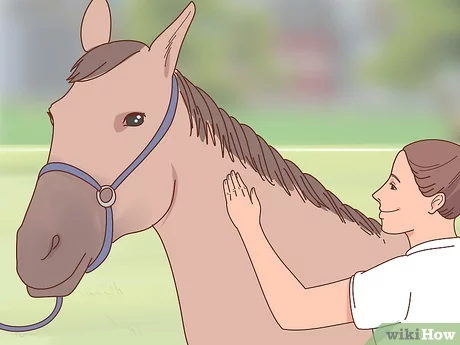
I’m afraid of horses! What to do?
I’m afraid of horses! What to do?
Every person has some kind of fear. Some are more pronounced, some are less. Someone is afraid of the dark, someone is afraid of dogs, someone is afraid of butterflies … Often there are people who are afraid of horses. In this article, I want to help you figure out your attitude to the situation. Because it is not always necessary to fight fear. In the vast majority of cases, you can just … make friends with him!
Where does fear come from?
So let’s first deal with the nature of your emotions. By and large, there are only two types of fear of horses:
— I’m afraid because I haven’t tried riding.
I’m afraid because I’ve already had a bad experience.
All fears, one way or another, are divided into these two categories. Even the mystical fear “I’m just afraid of horses, because I’m AFRAID!” can be attributed with full confidence to the first of them.
Regardless of where your fear comes from, whether it was originally, or acquired through trauma, it is worth accepting a simple truth: to be afraid – this is normal. There is nothing shameful or wrong in this.
Approaching the horse, we are dealing with a large, strong, shy animal, weighing about half a ton. The horse has hooves with which it can kick and large teeth with which it can bite. Once on the back of a horse, we accept the fact that if the horse wants to get rid of us, he will do it. Leading the horse by the reins, we are well aware that at any moment it can break free and gallop into the blue distances. There is no such heroic strength and such universal methods that could subdue any horse with a 100% guarantee and make it absolutely safe.
… But, at the same time, horses are kind, affectionate, beautiful and incredibly sincere creatures. Communication with them gives a lot of positive emotions. The horse is one of the first animals domesticated by man. We have lived side by side with horses for several thousand years… Therefore, many people want to curb their fear and learn how to communicate with them in such a way that this communication is mutually enjoyable.
If the craving for horses is irresistible, and fear prevents you feel normal – let’s learn to interact with this fear. I will tell you about my experience of working with fear and insecurity in beginner riders.
“I’m afraid because I haven’t tried”
If you’ve never ridden a horse, you might be thinking, “I’m afraid of horses because I’ve never tried riding.” It is a pleasure to work with such students! If at first a person is afraid to even stroke a horse, by the third or fourth lesson he already tries to gallop, and after two or three months he overtakes some more experienced riders in training.
If you think: “I am afraid!”, most often you simply do not realize what exactly you are afraid of, and whether you are afraid at all. Think about it… Try to carefully analyze your attitude to the situation. In most cases, you only think that you are afraid.
It may be more convenient for you to sit on a horse from a stump or stand for the first time. In most cases, it is this psychological barrier that is most difficult to overcome: “I can’t climb it!”. If you sit in the saddle from a hemp, the problem no longer seems so significant.
If you are not sure about the situation, do not immediately pick up the occasion. You don’t even need to know how to sit properly! Let the instructor simply lead the horse by the bridle for a few laps. In time, it takes only a couple of minutes, and the psychological clamp is melting before our eyes. Do not immediately strive to sit down correctly – you will tense even more. But during the first minutes, the most important thing is to relax as much as possible, because the more you relax, the more comfortable it will be for you and the horse.
Together with fear, the thought lives in my head: “It hurts!”. It is important to understand that only relaxation leads to harmony and comfort in the human-horse tandem.
The main task of the instructor when working with an uncertain rider: DO NOT SCARE the person with a forced situation. If you act gently and consistently, very soon the illusory fear will dissolve without a trace.
“I’m afraid because the horse scared me”
It is much more difficult to work with someone who is already scared after the fact of training. A person after a fall or injury is a different story. It happens that the rider did not even fall, the horse simply smashed him or tried to throw him off. In any case, rehabilitating such people is much more difficult than teaching from scratch. Just like with horses…
I am unspeakably happy when a person reports that he has never sat on horseback. This is practically a guarantee that there will be a minimum of problems in training. But when the rider managed to be like some not very decent rental, where he was scared, this is a difficult case.
Speaking about the good level of training for beginners, I want to emphasize one very important thing: if force majeure happens, the instructor must do everything so that fear does not take root. First of all, explain what happened in the most detailed way. Explain why the horse acted this way and not otherwise. Why did she suffer, play along or shied away. People who have been practicing for two or three years are able to assess the situation themselves, but a beginner is still poorly versed in the psychology of an animal. But every action of the horse has a reason! The instructor is obliged not only to see and understand this reason, but also to be an interpreter between the horse and the rider.
If you fall, try to get back into the saddle as quickly as possible, at least just walk. Let the instructor insure the horse at this moment – take it on the cord or by the bridle. Ask him to tell you what to do in such situations and how to avoid them. If the coach after your fall or a force majeure situation did not give any explanation, then it’s a disaster … Riders who were taught to ride by unfortunate instructors may have a fear of horses for many years.
What to do if you have already become a victim of such carelessness?
If you still have an interest and a desire to learn how to ride, the main task is not to be even more scared. Try to get used to the saddle again, in fact, start acquaintance with the horse from scratch. Search the Internet for the necessary material to UNDERSTAND the causes and consequences of different actions of the horse, consult with the trainer.
The problem is that you already know that any unforeseen action can be expected from the knight. At the level of an obsession, you wait for the situation to repeat and subconsciously constantly model it. But horses feel everything …
Sometimes, after a strong fright, the existing developments mutate into obsessive movements: leaning forward, pulling on the reins, sticking your heels into the sides of the horse … This can only provoke an unpleasant situation. So what to do?
Everything is simple. We have to start from scratch. And move forward exactly as fast as you can change your state.
For starters, it makes sense to practice without a reason, on the lunge. After a while, when you feel more or less comfortable, it is useful to include exercises without stirrups. If the obsessive movements are repeated, the stirrups can be removed completely, and the reins tied in a knot at the back of the horse’s head so that you cannot reach it. And – go ahead! Soft, not forced. Gymnastics, calm trot… When you are relaxed enough, it is useful to make transitions of walk-trot-canter. It is very good to walk for a few minutes with your eyes closed.
Already from the first lesson, you can slowly learn to control the reins again, but at first only on the step. Just in a circle. Then – volts, changes of direction. It’s the same as if you were learning from scratch. There is only one “but”: the trainer must constantly explain what the horse is doing and why. Calmly, consistently, as if voicing the thoughts of an animal. You need to understand the psyche of the horse, the logic of his actions. Then the fear will gradually recede; it will be replaced by the ability to adequately perceive any unexpected situations.
If you have been frightened by something, it is especially important not to rush. Be at least one step behind your desired lesson plan. Let progress happen and be fixed – only then move on to the next task. Try to understand what is happening as fully as possible and feel confident.
There are very advanced cases, but they are still quite rare. Horses are sick. If you have already started to practice, then most likely you will want to continue communicating with these animals. The task of the trainer is to help overcome the psychological barrier and secure the process of interaction as much as possible.
Fear is an ally
Of course, approaching an animal that weighs half a ton, a person feels a natural awkwardness. Some feel fear. This is absolutely normal – the instinct of self-preservation beeps. If it does not work when communicating with an animal, you risk getting a hoof in the forehead. There is nothing wrong with being afraid of a horse.
There is another extreme – very often a person is in illusions about a horse. No one in their right mind and sober memory will climb to stroke someone else’s fighting dog, saying “Oh, what ears! Oh, what a nose! .. ”, but they climb to the horses. Moreover, adults sometimes literally put their little children under the hooves of an unfamiliar horse. Why does a medium-sized dog make the instinct of self-preservation work, and a five-hundred-kilogram animal with four heavy hooves and a full mouth of teeth does not command due respect?
It is important to teach fear to help us learn. Do not try to drown out the instinct of self-preservation – it can be dangerous to life and health. Fear can work for us, stimulating us to better understand the situation, to better understand the psychology of the horse and the algorithms of its actions.
Try not to frighten the horse, give him the most simple, understandable and unambiguous commands. A calm rider will have a calm horse.
… And also – think ten times: do you need it? .. Maybe it’s easier to admire the horses from the side. Then there will be less fear. Also, it is far from always worth getting on the horse that you are afraid of. Change horse, change club, change coach! Look for the place, those people and animals with which you will be calm and comfortable. And remember: your life and health should come first. Don’t risk your head just to overcome your fear. Communication with horses should be fun and bring joy! Pay more attention to animal psychology. Ask the trainer to teach you how to work the horse on the ground. If possible, take the horse out to graze or go swimming with it. Look for harmony within yourself, and then the world around you will gradually come into balance.
Perhaps someday you will think: was it fear?
An excerpt from the book “Horse, rider, instructor: how to understand each other?”
Ksenia Krotova, horse riding and hippotherapy instructor





